
Over the course of more than 3000 years, ancient Egypt has given birth to various strongholds that shaped the legacy of this immortal nation. All the major ancient Egyptian cities were built on the banks of the Nile which represented the bloodstream for the entire civilization. Ancient Egyptian cities and towns were divided into lower and upper regions. The cities around the Mediterranean sea and the Nile delta were considered lower like Alexandria while upper Egypt were the cities located in the deep north such as Memphis and Thebes. The cities of ancient Egypt had different functions as some were political by nature that housed government workers and officials while other cities were religious also by nature. The Nile was the main factor that was a source of fresh water and cause behind the fertile farmlands which played an instrumental role in creating cities whose name will last until the end of days. The capitals of ancient Egypt were the largest and the most important. Throughout the history of ancient Egypt, the capital was in a state of transformation and constant change. Here are a list of famous Ancient Egyptian cities:
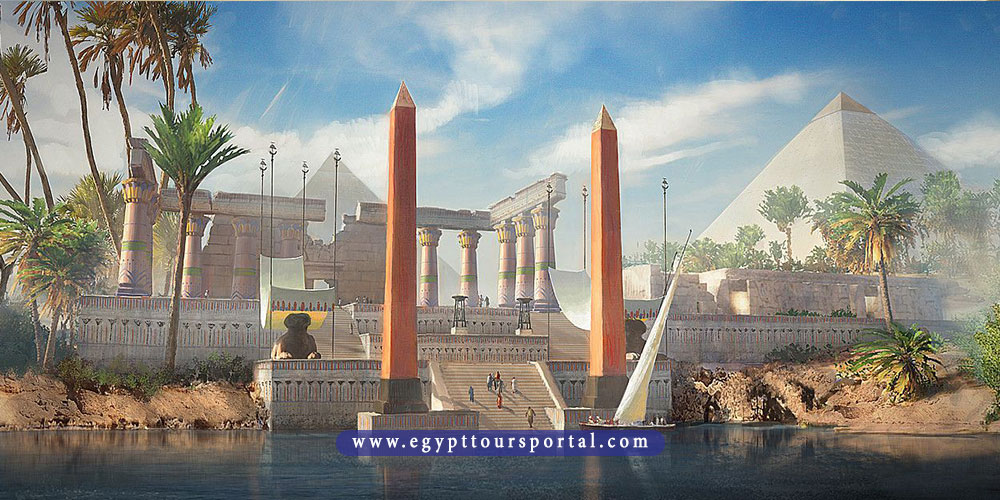 The first-ever capital of Egypt was the city of Memphis from 2950 BC to 2180 BC during the old and one of the official religious centers as it was the worship center for the holy triad of the creator god of Ptah, his wife Sekhmet and Nefertem. The city of Memphis is located 15 mi south of modern Cairo in lower Egypt. The stature of Memphis declined and served as a second capital after the rise of Thebes in the new kingdom of Egypt (15570-1070 BC). After the official capital was transferred to Alexandria in 331 BC and with the rise of Christianity, Memphis was completely abandoned and faded within time. Only a few ruins still exist today like an alabaster Sphinx and statue of Ramses II. Near Memphis lies the ancient city of Giza which holds the great pyramids complex.
The first-ever capital of Egypt was the city of Memphis from 2950 BC to 2180 BC during the old and one of the official religious centers as it was the worship center for the holy triad of the creator god of Ptah, his wife Sekhmet and Nefertem. The city of Memphis is located 15 mi south of modern Cairo in lower Egypt. The stature of Memphis declined and served as a second capital after the rise of Thebes in the new kingdom of Egypt (15570-1070 BC). After the official capital was transferred to Alexandria in 331 BC and with the rise of Christianity, Memphis was completely abandoned and faded within time. Only a few ruins still exist today like an alabaster Sphinx and statue of Ramses II. Near Memphis lies the ancient city of Giza which holds the great pyramids complex.
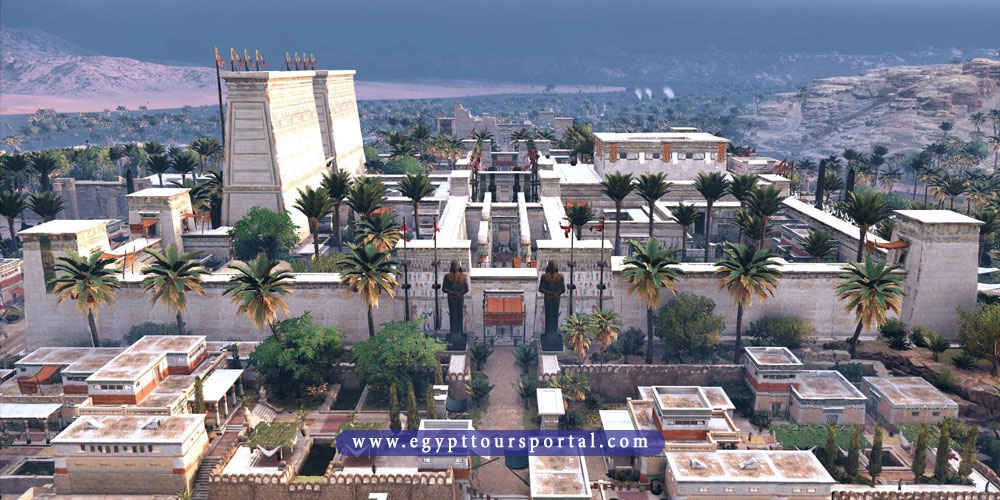 The great city of Thebes is the most well known in the history of ancient Egypt, it served as the capital of Egypt around 1279 BC during the new kingdom (1570-1070 BC). It is located 675 km (419 mi) south of Cairo on the east bank of the Nile. The city was the center of culture, rule, and religion. The city was called now as the city of the creator god Amun and was also referred to as Thebai by Homer the Greek poet who stated Thebes as the city with a thousand gates. The city was the location for some of the most famous and important festivals in ancient Egypt like the festivals of Opet and Shemu.
The great city of Thebes is the most well known in the history of ancient Egypt, it served as the capital of Egypt around 1279 BC during the new kingdom (1570-1070 BC). It is located 675 km (419 mi) south of Cairo on the east bank of the Nile. The city was the center of culture, rule, and religion. The city was called now as the city of the creator god Amun and was also referred to as Thebai by Homer the Greek poet who stated Thebes as the city with a thousand gates. The city was the location for some of the most famous and important festivals in ancient Egypt like the festivals of Opet and Shemu.
Across the history of the new kingdom various pharaohs like Ramsess II who constructed the majestic Abu Simbel temples, and Hatshepsut who constructed the beautiful Hatshepsut temple, both of the pharaohs are buried in the magical Valley of the Kings plus the famous boy king Tutankamun. One of the most famous landmarks in Thebes is the great Karnak temple the biggest religious ancient house of worship in history and next to it was the enchanting Luxor temple home to the holy triad of Amun, Mut, and Khonsu. Thebes became a world heritage site in 1979 by UNESCO because of the beauty and importance of this place to the history of mankind.
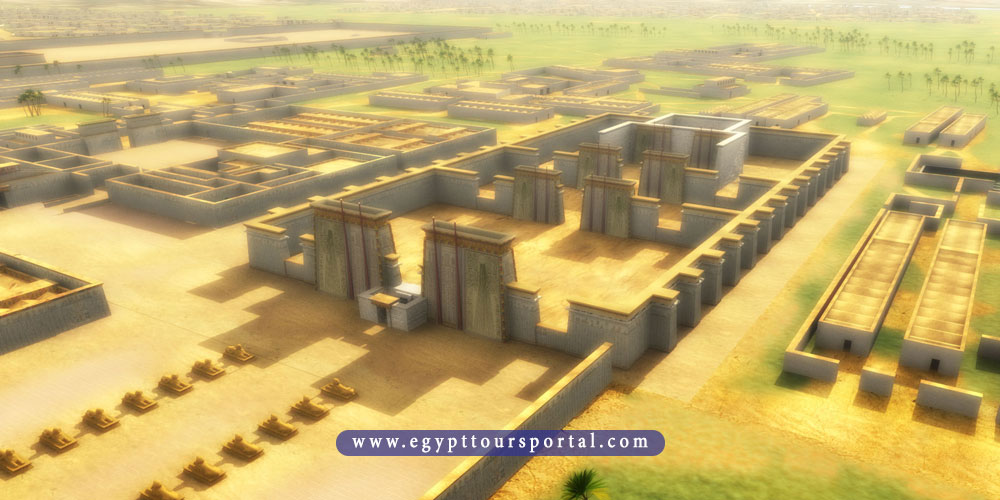 One of the most unknown capitals of ancient Egypt is Amarna, it represents the time of the biggest religious conflicts and struggles in ancient Egyptian history. The city was a capital established by Pharaoh Akhenaton (1353-1336 BC) in 1346 BC till his death in 1336 BC the city is located on the east bank of the Nile river about 312 km (194 mi) south of Cairo and 420 (250 mi) north of Luxor. Akhenaton ruled Egypt for 20 years where he tried to force a monotheist system, the worship of one god Aten "The Sun Disk" but after his death, his son Tutankhamen became the ruler then he amplified the polytheist system once again. The city was constructed with new forms of architecture called Akhetaten The site is known as Tell el-Amarna due to the Beni Amran tribe who lived in that area. The site holds some of the most beautiful tombs filled with the most mesmerizing inscriptions of the famous Aton the sun disk.
One of the most unknown capitals of ancient Egypt is Amarna, it represents the time of the biggest religious conflicts and struggles in ancient Egyptian history. The city was a capital established by Pharaoh Akhenaton (1353-1336 BC) in 1346 BC till his death in 1336 BC the city is located on the east bank of the Nile river about 312 km (194 mi) south of Cairo and 420 (250 mi) north of Luxor. Akhenaton ruled Egypt for 20 years where he tried to force a monotheist system, the worship of one god Aten "The Sun Disk" but after his death, his son Tutankhamen became the ruler then he amplified the polytheist system once again. The city was constructed with new forms of architecture called Akhetaten The site is known as Tell el-Amarna due to the Beni Amran tribe who lived in that area. The site holds some of the most beautiful tombs filled with the most mesmerizing inscriptions of the famous Aton the sun disk.
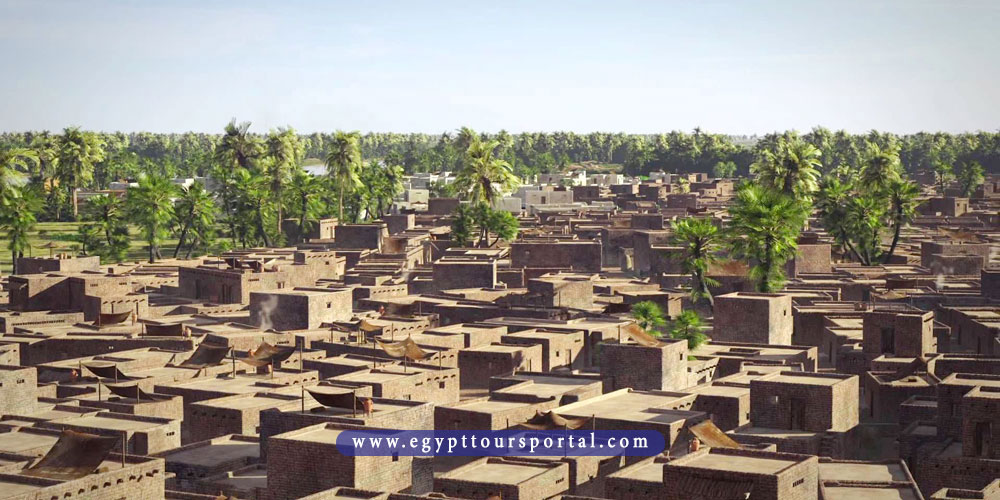 The city of Avaris used to be the capital of ancient Egypt under the Hyksos between 1783 BC and 1550 BC. It is located in the northeastern region of the Nile delta, it lies today at Tel El-Daba. The city was used as a trade center and an administrative location by the Hyksos and traders. The site is an important archaeological city as the ruins and artifacts like copper swords and grave goods found in the city are able to tell a great sum of facts and details about the Hyksos culture.
The city of Avaris used to be the capital of ancient Egypt under the Hyksos between 1783 BC and 1550 BC. It is located in the northeastern region of the Nile delta, it lies today at Tel El-Daba. The city was used as a trade center and an administrative location by the Hyksos and traders. The site is an important archaeological city as the ruins and artifacts like copper swords and grave goods found in the city are able to tell a great sum of facts and details about the Hyksos culture.
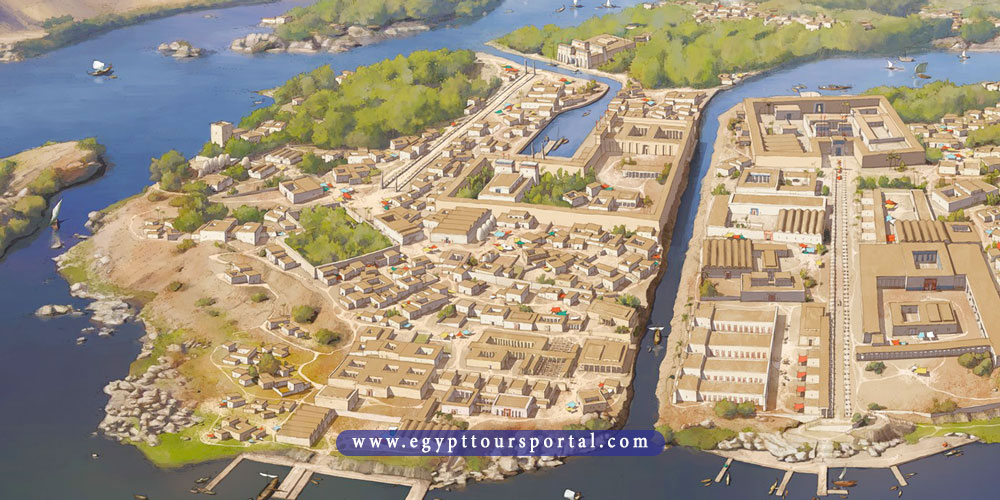 The city of Pi-Ramses was the new capital of ancient Egypt in the new kingdom in the reign of Ramses II (1279-1213) near the city of Avaris. It is located in the northeastern delta next to tell el dab and Qantar. The city was known as the house of Ramsess the great as it served as his residence for some time and as Turquoise city. It was known for being very enchanting as it had channels, lakes, and extravagant monuments and artifacts. the city divided into four parts, each part was named after a different deity Amun, Astarte, Wadjet, and Seth.
The city of Pi-Ramses was the new capital of ancient Egypt in the new kingdom in the reign of Ramses II (1279-1213) near the city of Avaris. It is located in the northeastern delta next to tell el dab and Qantar. The city was known as the house of Ramsess the great as it served as his residence for some time and as Turquoise city. It was known for being very enchanting as it had channels, lakes, and extravagant monuments and artifacts. the city divided into four parts, each part was named after a different deity Amun, Astarte, Wadjet, and Seth.
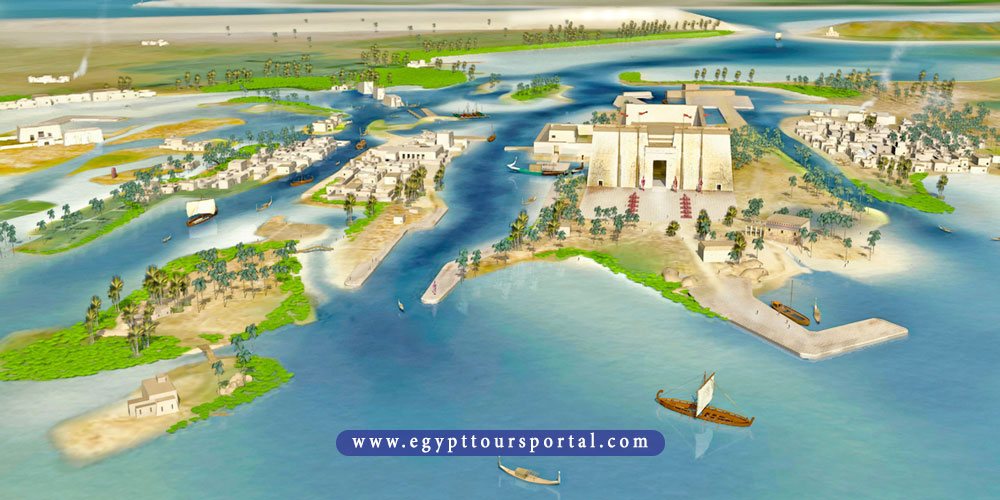 The lost city of Thonis was the capital in the first dynasty before Memphis, it is located near the ancient city of Abydos in Upper Egypt. It severs as a burial ground for the pharaohs of the first three dynasties. The site played an important role in mythology and religious cosmology like heaven which was mentioned in the book of the dead, it was known that the city held the tomb and mummy of the regional deity of Osiris. This site was the place whereof the first tribal confederation was announced and the unification of Upper Egypt by Menes "Narmer".
The lost city of Thonis was the capital in the first dynasty before Memphis, it is located near the ancient city of Abydos in Upper Egypt. It severs as a burial ground for the pharaohs of the first three dynasties. The site played an important role in mythology and religious cosmology like heaven which was mentioned in the book of the dead, it was known that the city held the tomb and mummy of the regional deity of Osiris. This site was the place whereof the first tribal confederation was announced and the unification of Upper Egypt by Menes "Narmer".
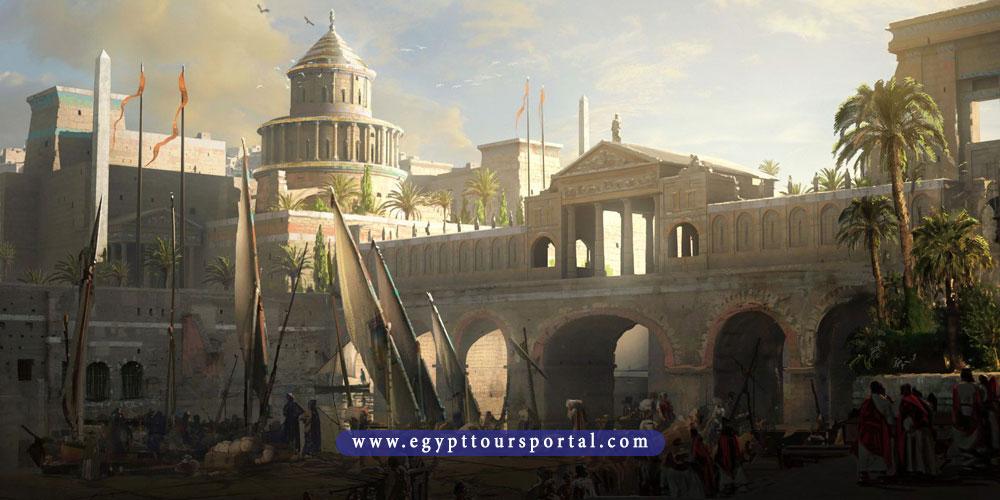 The city of Alexandria has served as the capital of Egypt from 332 BC to 641 AD, the city was constructed by Alexander the great to be the new center for the Hellenistic civilization to the new world of Africa, the middle east, and beyond. The city extends for 32 km along the coast of the Mediterranean sea and 138 km (114 mi) northeast of Cairo. The city was highly famous for containing the heavenly library of Alexandria between 285 BC and 247 BC, It held about 100,000 to 400,000 parchment scrolls in literature, science, medicine, and every other possible subject, in 48 the library was burned by Julius Caeser.
The city of Alexandria has served as the capital of Egypt from 332 BC to 641 AD, the city was constructed by Alexander the great to be the new center for the Hellenistic civilization to the new world of Africa, the middle east, and beyond. The city extends for 32 km along the coast of the Mediterranean sea and 138 km (114 mi) northeast of Cairo. The city was highly famous for containing the heavenly library of Alexandria between 285 BC and 247 BC, It held about 100,000 to 400,000 parchment scrolls in literature, science, medicine, and every other possible subject, in 48 the library was burned by Julius Caeser.
The city was known for holding one of the Seven Wonders of the Ancient World the lighthouse of Alexandria as it was the tallest man-made structure at the time, it was constructed between 284 BC and 246 BC and was destroyed by a series of three earthquakes between 956 AD and 1323 AD. The city holds the rare Roman catacombs which merges the ancient Roman and ancient Egyptian art and culture in the most mesmerizing manner. The city remained the capital for about a thousand years until the Islamic conquest in 641 AD where the capital was moved to the city of Fustat. Aside from the capitals there used to be great cities that were highly important to the evolution of the ancient Egyptian civilization, Egypt was divided into nomes which is a territorial division, the number of nomes changes through the different time periods, some of these cities are:
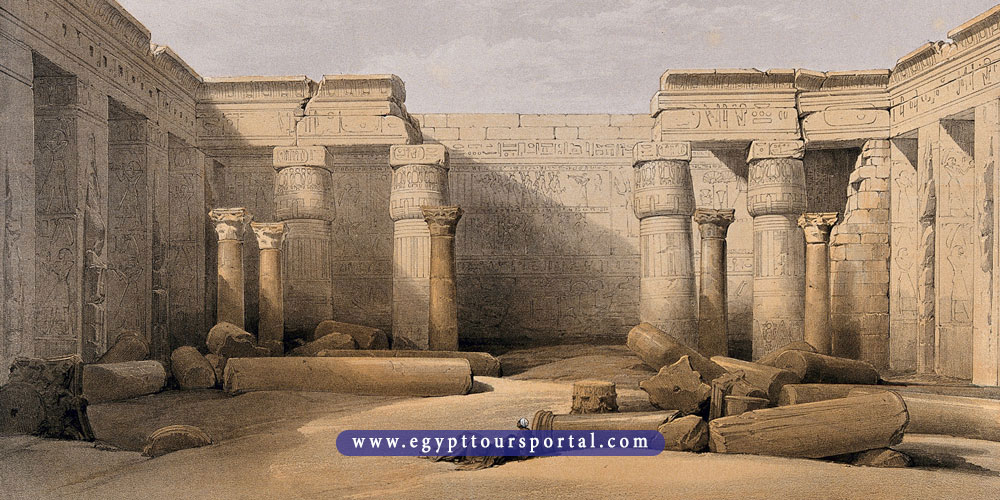 The city of Abydos was a place of high importance as it was known as the mythical burial place of Osiris and the home of his cult and. It is located in Upper Egypt and considered by far one of the most important archeological sites in Egypt. The city goes back to the time of the first dynasty more than 4500 years ago or even further. The site was used as a burial ground for the king of the first and second dynasties as the first pharaoh Narmer ' Menes' the founder of the first dynasty is buried in the temples of Abydos. The site was also a location where the Abydos Boats were constructed. The city of Abydos holds the great Osiris temple one of the oldest and the iconic construction in ancient Egyptian history. The temple of Seti I is the gem of Abydos as it is a highly beautiful and significant temple, it contains the Abydos King list which holds the names of many kings of the first and second dynasties which helped archeologist and historians to fully understand the ancient Egyptian history in the right manner. It was a favorite burial place for many kings and queens of the old kingdom.
The city of Abydos was a place of high importance as it was known as the mythical burial place of Osiris and the home of his cult and. It is located in Upper Egypt and considered by far one of the most important archeological sites in Egypt. The city goes back to the time of the first dynasty more than 4500 years ago or even further. The site was used as a burial ground for the king of the first and second dynasties as the first pharaoh Narmer ' Menes' the founder of the first dynasty is buried in the temples of Abydos. The site was also a location where the Abydos Boats were constructed. The city of Abydos holds the great Osiris temple one of the oldest and the iconic construction in ancient Egyptian history. The temple of Seti I is the gem of Abydos as it is a highly beautiful and significant temple, it contains the Abydos King list which holds the names of many kings of the first and second dynasties which helped archeologist and historians to fully understand the ancient Egyptian history in the right manner. It was a favorite burial place for many kings and queens of the old kingdom.
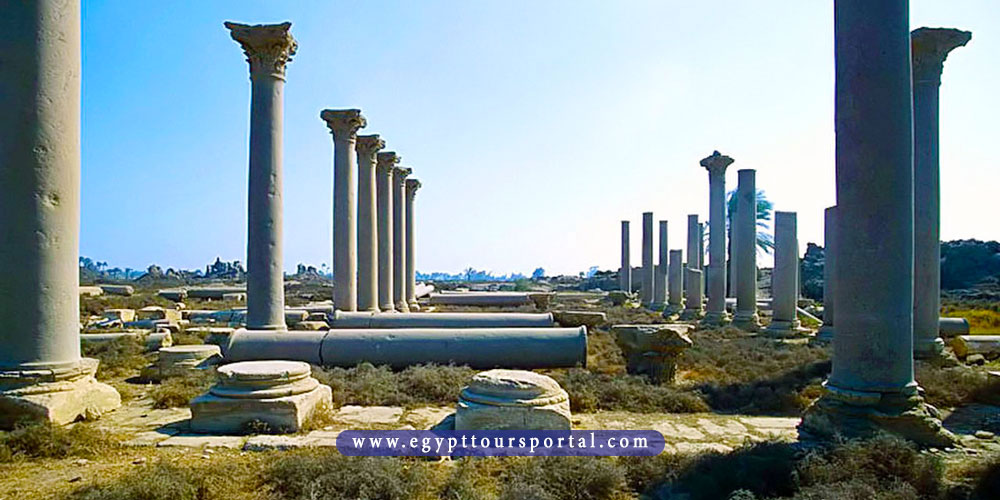 The ancient city of Hermopolis a.k.a Khumunu is located on the border between Upper and Lower Egypt. The city used to be one of the wealthiest and one of the biggest religious centers in ancient Egypt after Thebes. The city's history goes back to the times of the old Kingdom; the city was a quiet major in the Greco-roman period (332 BC-642 AD) but was completely abandoned after the Islamic conquest in 642 AD. The primary deity of the city was Thoth the god of magic, healing, and wisdom, and the patron of scribes. The city was also known as the city of Hermes as the messenger greek god.
The ancient city of Hermopolis a.k.a Khumunu is located on the border between Upper and Lower Egypt. The city used to be one of the wealthiest and one of the biggest religious centers in ancient Egypt after Thebes. The city's history goes back to the times of the old Kingdom; the city was a quiet major in the Greco-roman period (332 BC-642 AD) but was completely abandoned after the Islamic conquest in 642 AD. The primary deity of the city was Thoth the god of magic, healing, and wisdom, and the patron of scribes. The city was also known as the city of Hermes as the messenger greek god.
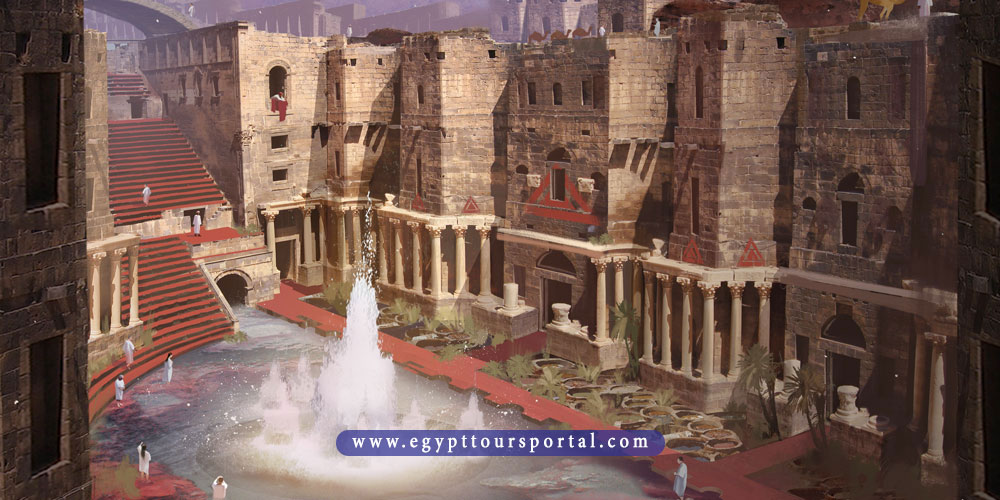
The city of Crocodiloplis also known as Shedet, modern-day Fayyum, the ancient city is located on the western bank of the Nile southwest of the ancient city of Memphis. The city became known as the crocodile city as it was the worship center for Sobek the crocodile god. The city can be traced back to around 4000 BC to the early days of the old kingdom which makes it one of the oldest cities in ancient Egypt. The city had a powerful religious significance and political power as it was located in the most fertile region in Egypt which made the city act as a haven for growing different kinds of vegetables, flowers, corn, and olives.
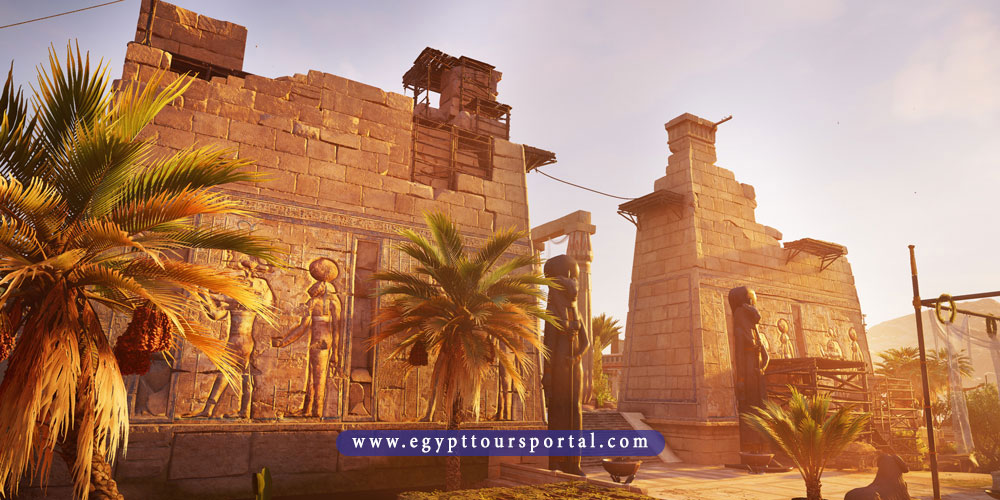 The ancient city of Elephantine was an ancient island that stood on the border between Egypt and nubia. It sits on the north of the first cataract of the Nile river, it is now considered to be part of Aswan. The city was one of the most important trading sites in ancient Egypt and a strong defensive site. It acted as a religious center for Khnum the god of the source of the Nile and the annual flooding.
The ancient city of Elephantine was an ancient island that stood on the border between Egypt and nubia. It sits on the north of the first cataract of the Nile river, it is now considered to be part of Aswan. The city was one of the most important trading sites in ancient Egypt and a strong defensive site. It acted as a religious center for Khnum the god of the source of the Nile and the annual flooding.
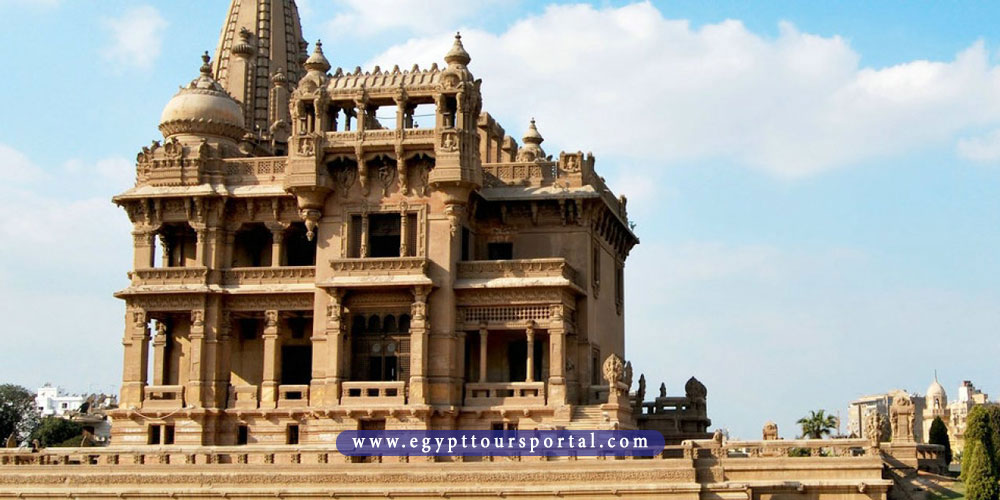 One of the oldest and most important cities in the history of ancient Egypt is Heliopolis. The city was probably the most important religious center ever created. The city is located in lower Egypt in northeastern Cairo. It was known as the city of the sun as it was the cult center for the sun god Atum and his birthplace and the creation of the deities of ancient Egypt Isis, Geb, Atum (Ra), Nut, Osiris, Set, Tefnut, Nephthys and Shu. Its city is famous for being the home of the Bennu bird and the legendary Phoenix. The city was the center of learning of philosophy and astronomy by great greek scholars like Homer, Plato, Herodotus, and many others.
One of the oldest and most important cities in the history of ancient Egypt is Heliopolis. The city was probably the most important religious center ever created. The city is located in lower Egypt in northeastern Cairo. It was known as the city of the sun as it was the cult center for the sun god Atum and his birthplace and the creation of the deities of ancient Egypt Isis, Geb, Atum (Ra), Nut, Osiris, Set, Tefnut, Nephthys and Shu. Its city is famous for being the home of the Bennu bird and the legendary Phoenix. The city was the center of learning of philosophy and astronomy by great greek scholars like Homer, Plato, Herodotus, and many others.
Every piece of land in ancient Egypt has a story to tell so don't miss the chance to listen to the stories of a lifetime. Through our Egypt tour packages & Nile river cruises, you will explore the ancient cities of ancient Egypt and discover the true meaning of greatness and beauty.
Private 4 Days Cairo Tour Packages for New Zealander Travelers 4 days Cairo Egypt To...
Tour Location: Cairo – Giza...
5 Days Cairo and Alexandria Tour Package For New Zealander Travelers 5 days Cairo an...
Tour Location: Cairo/Giza/Alexandria...
6 Days Cairo, Luxor & Aswan Tour Package For New Zealander Travelers 6 days Cair...
Tour Location: Cairo/Giza/Aswan/Luxor...
Amazing 7 Days Cairo and Hurghada Holiday for New Zealander Travelers 7 Days Cairo &...
Tour Location: Cairo – Giza – Hurgh...









